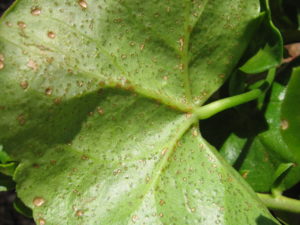Oedema Is a Corky Quirk
Plants that experience extremes in soil moisture may develop spots on their leaves, called “oedema” (also spelled “edema”). The spots may first appear as a blister or raised spot, particularly on the undersides of leaves, but may occur on the top side as well as on the stems. Eventually, the blister develops a rust-colored, cork-like scab.
Oedema is most commonly seen in the greenhouse on ivy-leaf geraniums but also on pansies, jade, and other thick-leaved plants. When plants have been subjected to overly dry conditions, followed by abundant moisture, the plant cells take on too much water too rapidly, causing them to burst.
Oedema can also occur on outdoor plants. The blisters appear when soils are abundantly moist, coupled with cloudy, humid weather.
Oedema spots do not spread, but the scab will remain unsightly. The dead tissue may dry and fall away on thin-leaved plants, leaving a “shot-hole” appearance.
To prevent oedema from occurring, avoid extremes in watering practices. Feel the soil of houseplants before you water to be sure the soil needs additional moisture. Mulching outdoor plants will help avoid extremes in the soil moisture supply.

